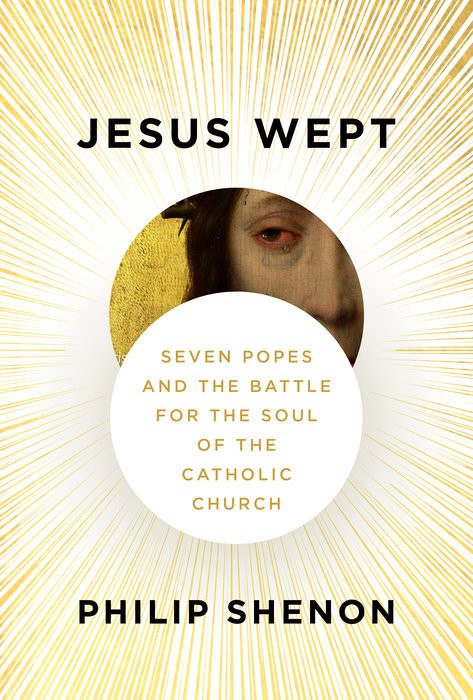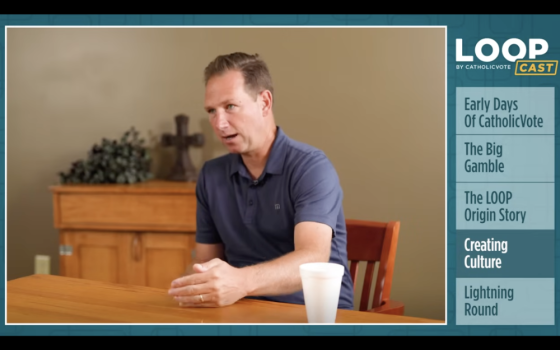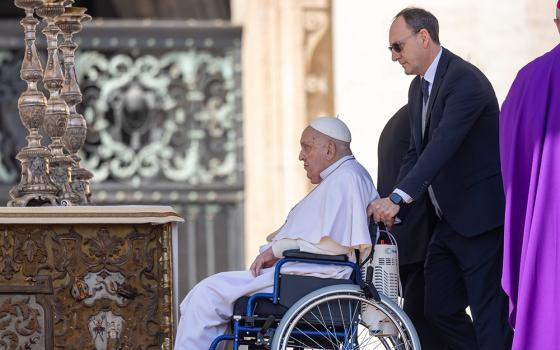Pope Francis visits his predecessor, retired Pope Benedict XVI, at the Mater Ecclesiae Monastery at the Vatican in this Dec. 21, 2018, file photo. (CNS/Vatican Media)
Acclaimed journalist Philip Shenon's new book Jesus Wept: Seven Popes and the Battle for the Soul of the Catholic Church seemed like a must-read tome when a review copy arrived this winter. Unfortunately, the work is plagued by errors of fact, analysis and understanding.
The factual errors start soon. On page 29, Shenon criticized the papacy of Pope Pius IX and then turns to "His successor, Pius X." Except, Pope Leo XIII succeeded Pius IX, not Pius X, and Leo's 25-year reign was consequential for many of the issues of ecclesial reform and social engagement that dominate the rest of the book.
Such basic errors of fact persist. Writing about Cardinal Joseph Ratzinger's tenure at the Congregation for the Doctrine of the Faith, Shenon states, "Under Ratzinger, it [the CDF] had abandoned a tradition dating from the 19th century known as 'subsidiarity,' which held that church problems should be handled on the lowest-possible level of authority, without any involvement by the Vatican." Subsidiarity is a part of Catholic social teaching, not ecclesiology. What is more, the century witnessed the heyday of ultramontanism, which concentrated all authority in the Vatican.
The factual mistakes do not subside as we get closer to our own time. Writing about the 2014 Synod on the Family, Shenon states it was "an event many Catholics were already comparing to Vatican II, since it was the first time since the council that the world's bishops were promised they could speak with absolute freedom." The 2014 synod assembled a few hundred bishops. Vatican II had assembled all the world's bishops, more than 2,500. And it was Pope Benedict XVI who had begun allowing bishop delegates to the synod to speak freely and on any topic for the last hour of each day's gatherings during the synods he held.
I could have noted dozens of other such mistakes.
Similar errors also stain Shenon's analysis of his subjects, and a common pattern emerges. His simplistic narrative reduces complex figures to caricatures: Pope John XXIII is a reforming hero; Pope Paul VI is a wet blanket; John Paul II and Benedict XVI seek to undo Vatican II. Swiss theologian Hans Küng is a brave reformer while Joseph Ratzinger is a turncoat, abandoning his commitment to reform. Anything that complicates such 'cops-and-robbers' narratives is ignored and incorrect facts that bolster it are introduced.
So, for example, when describing the opening Mass at Vatican II, Shenon writes, "John appeared indifferent to the pomp around him and was crying tears of joy." In fact, John XXIII loved the pomp and pageantry of grand liturgies like the one that opened Vatican II. But that wouldn't square with Shenon's portrait of him as a modernizer.

The cover of "Jesus Wept: Seven Popes and the Battle for the Soul of the Catholic Church" by Philip Shenon.
On page 23, Shenon writes, "By the late 1960s, there was only one young Catholic theologian who came close to his [Küng's] renown in the German-speaking world – Father Joseph Ratzinger. I think he meant the 1950s because he is writing about the preconciliar era, but more importantly, what about Karl Rahner, who was easily the most prominent German-speaking theologian of the time. Shenon knows this because 45 pages later, he writes that Rahner was "seen by German Catholics as their country's greatest living theologian." The earlier passage sets up the rivalry between Küng and Ratzinger, which runs through the whole book as a central reality in the life of the church. It wasn't.
Shenon doesn't much like Ratzinger and writes foolish things to make him appear sinister. "Within a few years of arriving in Rome, Ratzinger's authority extended beyond his congregation," Shenon writes. "With John Paul II's encouragement, he became directly involved in the selection of bishops and cardinals." Every prefect of the CDF has been named to the Congregation, now Dicastery, for Bishops. There is nothing remarkable, still less sinister, about it.
Worse, Shenon tries to pin the blame for the cover-up of sex abuse committed by Fr. Marcial Maciel, the founder of the Legion of Christ, on Ratzinger. In fact, Ratzinger initiated the investigation of the corrupt Maciel, but it was blocked by John Paul II and Cardinal Angelo Sodano. Once Ratzinger was elected pope, he dispatched the Catholic Church's lead investigator, Archbishop Charles Scicluna, to resume the investigation, and Maciel was sacked soon after.
Writing about Cardinal Jorge Mario Bergoglio, who would become Pope Francis and in his 2010 biography, Shenon states: "The pontiff he praised most in the book was John XXIII, who met his definition of what a pope should be – concerned with people, not doctrine." That is a false choice. Both popes are rightly deemed pastoral, which means they are gentle in the application of doctrine to persons, but their commitment to the human person is rooted in Catholic doctrine.
It is astonishing that Shenon briefly summarizes John XXIII's early life but leaves out one of the most consequential events. He notes that he took a degree in theology in Rome but leaves out young Fr. Roncalli's visit to the Archiepiscopal library in Milan on February 23, 1906. That day, Roncalli came across 39 parchment-bound volumes containing the records of St. Charles Borromeo's pastoral visits to the Diocese of Bergamo, Roncalli's home diocese. These were, in Roncalli's words, "rich and fascinating documents concerning the church of Bergamo at the most characteristic period of its religious renewal, just after the Council of Trent, in the most ardent period of the Counter-reformation." It became Roncalli's life's work to edit those volumes, a task he completed not long before his election as pope some 50 years later.
This doesn't fit Shenon's narrative. For him, Roncalli's decision to summon Vatican II amounted to a repudiation of the Tridentine church, but that is not how Roncalli saw it. His familiarity with the pastoral reception of Trent shaped his understanding of the renewal he sought by calling Vatican II. He understood that true reform was rooted in sound doctrine. How could it be otherwise?
Shenon's treatment of Vatican II – the preparation for the event, the four sessions of the council, and its reception – dominates much of the book because the council is the frame for all ecclesial debates from its beginning in 1962 until today. His analysis of the council displays a failure to understand how Catholic theology and practice developed and a specific failure to grasp what did, and did not, happen at Vatican II.
Cardinal Karol Wojtyla, who later became Pope John Paul II, is congratulated by Pope Paul VI at his installation as cardinal in the Sistine Chapel June 26, 1967. (CNS)
In his telling, the good guys (reforming bishops) are set against the bad guys (the conservative curial bishops). There is some truth in that, but from the earliest votes, it became clear the curial bishops were not driving the agenda. The central tension in the debates – and the final texts – was between the two competing hermeneutics for reform: aggiornamento (or bringing up to date) and ressourcement (returning to the sources). Each conciliar document reflects those two impulses, and none of the documents of Vatican II prioritizes one over the other. It is telling, and frankly shocking, that the word ressourcement does not appear once in Shenon's text.
The entire postconciliar period is dominated by the tensions between these two hermeneutics. Concilium and Communio became the two competing theological journals for the two approaches. The church needs both. "Conceived simply as the updating of theology, aggiornamento is never finished catching up; conceived more grandly as modernization, it is already far behind," wrote Dominican Archbishop J. Augustine Di Noia in his recent book Theology as an Ecclesial Discipline: Ressourcement and Dialogue.
"On the other hand, ressourcement theology has sometimes shown itself unwilling or unable to confront and resolve the conceptual problems — the quaestiones, as Aquinas might say — that the sources themselves serve up. Lectio is not always enough." The best theologians working today seek to find bridges between the two schools, just as the Council Fathers did while drafting their documents. Those who insist on one or the other are theologians who become irrelevant.
Such distinctions are lost on Shenon. He sticks to his good guys vs. bad guys framing, even when it makes no sense. His conflation of concern for the poor with liberation theology leads to grave misunderstandings of the dynamic of the Latin American church. His shabby treatment of Pope Paul VI reflects his belief that good popes are those who embrace liberalizing reforms when the first task of the pope is to serve as a point of unity for the church. I have concluded that Paul VI was the outstanding pope of the 20th century, bringing the council to a successful close and beginning its reception. Shenon never forgives him for Humanae Vitae and its ban on birth control, stating at one point that the encyclical was "the most consequential encyclical of modern times."
Nonsense. Shenon never once mentions Paul's 1975 Apostolic Exhortation Evangelii nuntiandi, which has proven a far more consequential and fruitful text, echoing through the encyclicals of all of his successors, including Francis.
This book is a disservice to the rich history and complicated personages it surveys. Entrusting a book like this to someone with no working knowledge of Catholic history and theology has resulted in a volume that distorts more than it enlightens.
Jesus wept indeed.
Advertisement







